

IN MEMORy by Pierre Vandervelden
The visit of Commonwealth graves in Communals Cemeteries & Churchyards in Belgium & France
SEDAN (St. Charles) Communal Cemetery (Ardennes France)
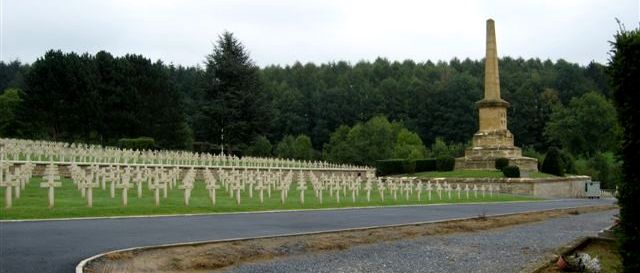 |
| Photo courtesy Jean-Michel Dominique (Bel) |
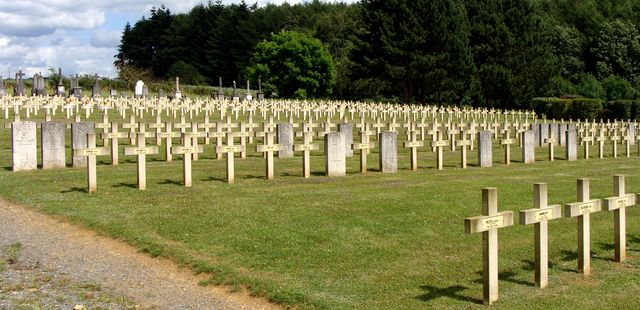 |
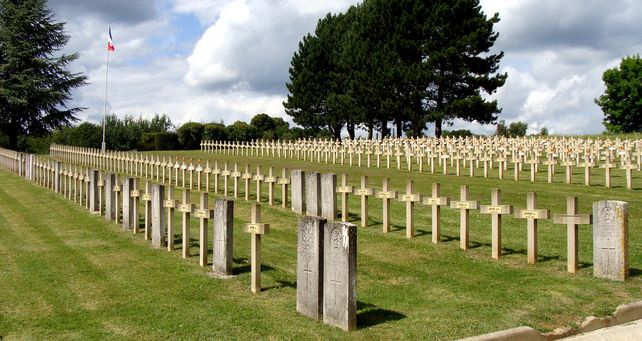 |
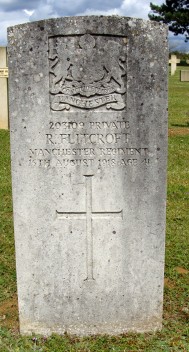 |
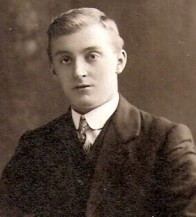 |
| Pte Robert Flitcroft 15/08/1918 aged
41 for Carol |
|
 |
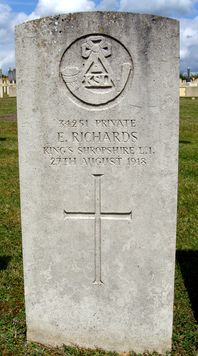 |
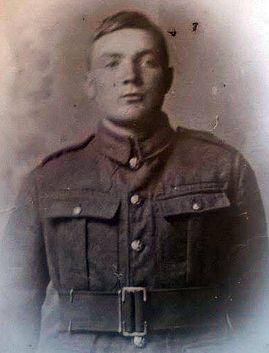 |
| Pte Evan Richards 27/08/1918 aged 19 for Phillip Jones and the Radnorshire Museum (Mid Wales) (portrait courtesy of Vera Wozencraft) Left, the Llanbister war memorial. |
||
| Evan was born in about 1899 in Llanbister. In 1901 the family consisting of his father Edward a farmer and his Mother Jane were living at Brynwidoc Llanbister. In the 1911 census the family who now numbered 10, Dad Mum 5 Sons and 3 Daughters were all still living at Brynwidoc, Evan who was 12 years old was in School. Evan enlisted into the British Army on 26/06/1917 and after initial recruit training he landed in France around 10/1917 and became part of C Coy of the 1st bn Kings Shropshire Light Infantry, the 1st bn had been formed in 08/1914 in Tipperary Ireland, the bn came under the command of the 16th Infantry Brigade within the 6th Division. The bn had landed at St-Nazaire France on 10/09/1914. During 10/1917 the bn would receive new drafts from England. These new reinforcements would amount to some 116 other ranks and would be with the bn by the end of October. On the 17/10/1917 the bn with its division (the 6th Division) was withdrawn for a rest to the St.Hilaire area west of Lillers, a week later it commenced its march south to join the third army for the battle of Cambrai. The bn proceeded via Le Brebis, Noeux-les-Mines, Honeng-hem and Ostreville to a rest stop at Ivergny, arriving here on 30/10/1917. During the battalions time at Ivergny they were to practice attacks with tanks until the 15/11/1917 when the bn entrained at Bouque Maison for Peronne. From Peronne the bn marched north to Moislans, arriving at 2.30am on the 16/11/1917 continuing the march at 6pm to Dessart Wood one mile north-east of Fins here the bn encamped for the night. The Cambrai operations would rage on from the 20/11/1917 - 30/12/1917, this was a British attack, it was originally conceived as a very large scale raid, that was to use new artillery methods and massed tanks. Initially it was very successful with much ground being made, but German reserves brought the British advance to a stop ten days later; and a counter attack regained much of the ground. Overall a disappointing and costly result, on 09/12/1917 the 6th Division was withdrawn to rest in the Basseux area south west of Arras. The bn proceeded via Sorrel to Courcelle-le-Comte 5 miles north west of Bapaume. On the 01/01/1918 the bn left Courcelle-le-Comte and marched to billets at Bailleulval here they continued training until the 20/01/1918 when they returned to Courcelle-le-Comte. On the 21st the 6th division having relieved the 51st division on the Hermies-Boursies front, the bn marched to Fremicourt and five days later relieved the 2nd Sherwood Foresters (71st Infantry brigade) in the right sector of the divisional front line between Demicourt and Boursies. While in this position the bn experienced quiet times with nothing noteworthy to record they were relieved on the 03/02/1918 and went back to billets at Fremicourt. On the 10/02/1918 the bn moved north and then on the 12th they relieved the 8th bn Border regiment in the trenches at Lagnicourt, they were themselves relieved on the 21/02/1918, the bn then spent the rest of the month in billets at Favreil. During early February 1918 owing to the shortage of man power, the infantry brigades were reduced from four bns to three bns and so many bns were disbanded. By 01/03/1918 the bn were back in the line in front of Lagnicourt, it was recorded that the weather was fine but cold and that all was exceptionally quiet. It was the lull before the storm, the sector remained unusually quiet, but reports were rife from German deserters that the British front line was to be heavily attacked, the bn was constantly ‘standing to’ (getting ready for action). The whole of the 6th Divisional front was on a forward slope opposite and south of the villages of Queant and Prouville on a line between Noreuil-Lagnicourt-Morchies. No man’s land averaged about three-quarters of a mile deep, and the country was largely downland particularly suitable for tanks. The bn trenches were on the ground that had been taken from the enemy during the battle of Cambrai in 11/1917 and having been hastily improvised they were very imperfect for defence. The 16th Brigade now only three bns strong, was on the left of the 6th Division, covering a front line of some 1,500 yards. Each brigade was covering its front with one battalion with two battalions held in depth in the battle area. After a nerve racking fortnight of expectancy the German Offensive began at 5am on March 21st 1918. The German spring offensive or Kaiserschlacht (Kaisers Battle), also known as the Ludendorff offensive was a series of German attacks along the Western front, this offensive marked the deepest advances by either side since 1914. The bn war diary recorded the following: "21st March 1918, Desperate enemy offensive commences remnant of battalion mixed with portions of other units endeavour to hold the enemy in the Haig line, inflicting enormous losses on the enemy, before retirement to the Haig line, those of the battalion (the great majority under Colonel H. M Smith DSO seeing themselves surrounded determined to fight to the last. Owing to the fact that very few got away from this Melee very little is known of the actual details of this fight. It was also recorded that at sunset a handful of the battalion under Lieutenant A. B Rogers M.C were still in the Haig line." As time went on more details emerged about this action, the German spring offensive started on 21/03/1918 at 5am with an intense German bombardment which lasted five hours. The German infantry attack which was launched with a great dash and an over whelming superiority of numbers, drove back the 59th Division on the left of the 16th Infantry brigade into the outskirts of Noreuil. This left the left flank of the 1st bn Kings Shropshire Light infantry, which was opposite Queant, and on the extreme left of the division, in the Air. The bn had A & B companies in the line, disposed along the front line in posts, consisting of eight to ten men, some seventy yards apart. These two companies, in common with the garrison of the forward system all along the line, were almost annihilated in the first hour and a half of the bombardment. By 7 am the enemy were reported to be through the British front line. An hour later the enemy were reported through on the battalion’s right. Lt-Colonel Smith, commanding, went forward to D company, in reserve, to lead a counter attack, and Captain Platt, the Adjutant, went to investigate the position on the battalion’s right. No news of A, B or C company (in support), was received, all forward communications being cut, and on arrival at D company the Colonel found them heavily engaged. Captain Platt was not seen again, and at 10am with both flanks in the air, the bn was in a desperate situation. Sending back Lieutenant Moody, of the 1st bn the buffs and some thirty men of that battalion, to cover the retreat Lt-Colonel Smith decided to retire. Lt Moody was killed soon after leaving the Colonel fighting to the last and refusing to surrender. Lieutenant Jackson-Taylor was sent to ascertain whether Lt Moody’s party were in position and he was also killed, and when D company commenced to retire they found the enemy already in their rear. Those of the battalion who had not already been killed at their posts were thus caught in a trap and surrounded without bombs and or machine guns. The remnants of the 1st Kings Shropshire Light infantry endeavoured to break out, armed only with their Bayonets, few being successful. When darkness fell the remnants of the bn, less than 100 strong, were in the Corps line to which the whole divisional front had been forced back. At 7.30 am the survivors of the 16th Infantry brigade, at the Haig line, were again heavily attacked, fighting desperately the seventy odd survivors of 1st Bn Kings Shropshire Light Infantry under Lieutenant A. B Rogers, wedged between the 1st bn Buffs and the 2nd bn Yorks and Lancashire rgt were forced back unto Vaulx. At dusk the bn (if such it can be called) received orders to retire to the General Headquarters line (GHQ), behind Vraucourt. On the morning of the 23/03/1918 what was left of the bn was relieved and, under Major H de R. Morgan of the 1st bn the Buffs, proceeded to Achiet-le Grande, and from thence on the following day, by train from Puissieux to bivouac in the citadel at Doullens. They then headed for Rousbrugge, seven miles North West of Poperinghe, and marched to Chauny camp, where they arrived at 6.30 in the morning of the 25th for rest. Sadly casualty figures in the 16th Infantry brigade during the fighting of March 21st/22nd 1918 are not available. Of the other two brigades of infantry in the division it is recorded that, out of a strength of 1,800 all ranks in each brigade, the survivors in the 18th Infantry brigade numbered 8 officers, 110 other ranks, in the 71st Infantry brigade, 11 officers and 279 other ranks. Of those in the 1st bn Kings Shropshire Light Infantry, 77 other ranks survived, on the evening of 22/03 22nd the total strength of the 1st bn Kings Shropshire Light infantry on arrival at the rest camp on March 25th was 13 officers and 492 other ranks. It could be said that they had had enough at this point and deserved their rest, however fate would play another trick for almost as soon the 1st bn KSLI arrived at Chauny the rest they were looking forward to was denied them, as the remnants of the 6th division were ordered north to join the second army in the Ypres salient. Evan who had survived the fighting had been taken prisoner by the Germans on the 21/03/1918, sadly 19 year old Evan died on the 27/08/1918 while still in captivity, his Red Cross card states that he died from dysentery. The International Red Cross kept records of prisoners of War but they often only contain the barest information and in Evan’s case his card includes the German phrase ‘details are missing’ but we can learn from the card that after his death from Dysentery. He was buried in a single grave in Sedan (St Charles) Communal Cemetery. The précis camp that he was held in remains a mystery, there is reference to the POW camp at Friedrichsfeld but this is many miles from where he was buried. Freidrichsfeld camp was something of a model camp with large open spaces that the inmates used for vegetable gardens and football, it was also home to 35,000 prisoners many of whom were sent out on work parties to coal mines and factories, disease was rife here but there was very little by the way of hospital facilities. The men were given one slice of bread a day and contemporary diaries tell tales of the guards offering the POW’s 20 Pfennigs for their bread rations as by this time Germany was close to starving. Evan may have been sent here first and fallen ill while on a work party. Some of the prisoners although officially registered as residing at Freidrichsfeld could actually be working a good days march or even a train ride away from the camp, in some cases the camp was no more than a postal address for a prisoner who may have passed through but may be working and sleeping in a coal mine many miles away. Evan was buried in the central courtyard of cemetery at Sedan St.Charles, unlike other commonwealth cemeteries this one was and still is in use. Sedan was in the hands of the Germans for almost the entire war and they had everything from factories to brothels and cinemas to training grounds in the town. There were also several sizeable hospitals in and close to the town. The Germans even built a large memorial to their own dead in the town’s local cemetery. There are only 50 British soldier’s graves which date from WW1 in Sedan St Charles cemetery they are dotted among the graves of Russian French and Rumanian service men as well as approx 700 civilians who died in WW1. All 50 graves are from men who died during a short space of time they could all have been prisoners’ alongside Evan. 19 year old Evan Richards is also remembered on the Llanbister war memorial. |
||
51 casualties
ANDERSON JOHN
United Kingdom Private Argyll and Sutherland Highlanders 14th Bn. Age: 21 Date
of Death: 29/07/1918 Service No: S/21821 (461)
ANGUS R
United Kingdom Private Black Watch (Royal Highlanders) 1st/6th Bn. Date of Death:
09/07/1918 Service No: 267952 (298)
BACHE THOMAS HENRY
United Kingdom Private Sherwood Foresters (Notts and Derby Regiment) "D"
Coy. 2nd Bn. Age: 19 Date of Death: 23/07/1918 Service No: 93579 (479)
BECKLEY ARTHUR ERNEST
United Kingdom Private Royal Berkshire Regiment "C" Coy. 2nd Bn. Age:
26 Date of Death: 08/09/1918 Service No: 31136 (430)
BIRCH E A
United Kingdom Private Somerset Light Infantry 6th Bn. Date of Death: 17/05/1918
Service No: 30291 (350)
BROWN A E
United Kingdom Lance Corporal Rifle Brigade 16th Bn. Date of Death: 24/08/1918
Service No: 6600 (439)
BURDON A
United Kingdom Private Middlesex Regiment 2nd Bn. Date of Death: 03/07/1918
Service No: 21856 (314)
CANNON FREDERICK WILBUR
United Kingdom Private Royal Sussex Regiment 13th Bn. Age: 29 Date of Death:
05/07/1918 Service No: G/18011 (306)
CARPENTER ARTHUR EDWARD
United Kingdom Private Royal Sussex Regiment 3rd Bn. Secondary Labour Corps
Secondary transf. to (206155) 146th Coy. Age: 32 Date of Death: 03/06/1918 Service
No: G/2105 (336)
DAVISON NORMAN
United Kingdom Private West Yorkshire Regiment (Prince of Wales's Own) 1st Bn.
Age: 23 Date of Death: 08/06/1918 Service No: 56919 (330)
DICKINSON ROBIN
United Kingdom Private East Lancashire Regiment 11th Bn. Age: 26 Date of Death:
14/10/1918 Service No: 34905 (398)
DREA K
United Kingdom Private Royal Irish Regiment 2nd Bn. Age: 36 Date of Death: 06/07/1918
Service No: 5258 (302)
ELLIS HARRY
United Kingdom Private Lincolnshire Regiment 7th Bn. Age: 23 Date of Death:
15/09/1918 Service No: 26967 (424)
EVANS I
United Kingdom Private Machine Gun Corps (Infantry) I9th Bn. Date of Death:
14/10/1918 Service No: 127495 (399)
FLITCROFT ROBERT
United Kingdom Private Manchester Regiment 1st/7th Bn. Age: 41 Date of Death:
15/08/1918 Service No: 203109 (448)
FYFE D
United Kingdom Private Argyll and Sutherland Highlanders 1st/7th Bn. Date of
Death: 26/05/1918 Service No: 203093 (344)
GLENISTER OLIVER VICTOR
United Kingdom Private Oxford and Bucks Light Infantry 2nd Bn. Age: 22 Date
of Death: 29/10/1918 Service No: 10386 (622)
GLENNERSTER REGINALD LOFT
United Kingdom Private Royal Marine Light Infantry 1st Bn. R.N. Div. Age: 22
Date of Death: 22/05/1918 Service No: CH/17960 (345)
GOLDSMITH J J
United Kingdom Private Manchester Regiment 12th (Duke of Lancaster's Own Yeomanry)
Bn. Date of Death: 23/07/1918 Service No: 52503 (480)
GORDON JAMES
United Kingdom Private Gordon Highlanders "B" Coy. 4th Bn. Age: 19
Date of Death: 12/07/1918 Service No: S/20525 (508)
GRIEVE A
United Kingdom Lance Serjeant Gordon Highlanders 4th Bn. Date of Death: 29/08/1918
Service No: 202642 (436)
HALLYBURTON A
United Kingdom Private Black Watch (Royal Highlanders) 1st/6th Bn. Date of Death:
24/07/1918 Service No: 265849 (477)
HARGREAVES FRED
United Kingdom Private East Lancashire Regiment 11th Bn. Age: 33 Date of Death:
18/09/1918 Service No: 37822 (422)
HINTON WILLIAM HENRY
United Kingdom Private The Queen's (Royal West Surrey Regiment) 6th Bn. Age:
29 Date of Death: 15/10/1918 Service No: G/14237 (632)
HOLT JAMES JACKSON
United Kingdom Private Lancashire Fusiliers 2nd Bn. Age: 31 Date of Death: 02/08/1918
Service No: 45404 (457)
HOWARTH P
United Kingdom Private The King's (Liverpool Regiment) 4th Bn. Date of Death:
09/07/1918 Service No: 269164 (499)
JONES DAVID THOMAS
United Kingdom Private The Buffs (East Kent Regiment) 7th Bn. Age: 25 Date of
Death: 31/08/1918 Service No: T/202389 (509)
LESLIE A J
United Kingdom Private Gordon Highlanders 4th Bn. Age: 24 Date of Death: 05/07/1918
Service No: 201484 (304)
MARSHALL CHARLES
United Kingdom Private Black Watch (Royal Highlanders) "D" Coy. 9th
Bn. Age: 26 Date of Death: 13/10/1918 Service No: 266442 (407)
McFARLANE G E
United Kingdom Private Gordon Highlanders 1st/4th Bn. Date of Death: 19/09/1918
Service No: 235636 (420)
McLAREN KENNETH
United Kingdom Gunner Royal Field Artillery 256th Bde. Age: 28 Date of Death:
18/09/1918 Service No: 229885 (423)
McLEOD D
United Kingdom Gunner Royal Garrison Artillery Date of Death: 09/04/1918 Service
No: 114388 (383)
McRAE J
United Kingdom Private Black Watch (Royal Highlanders) 1st/7th Bn. Date of Death:
28/10/1918 Service No: 291593 (623)
MELVILLE ROBERT
United Kingdom Bombardier Royal Artillery 7 Survey Regt. Date of Death: 18/03/1945
Service No: 995991 (331)
MONTGOMERY R
United Kingdom Lance Corporal Gordon Highlanders 1st/7th Bn. Date of Death:
18/07/1918 Service No: S/15234 (488)
NEWMAN A
United Kingdom Private Durham Light Infantry 1st/6th Bn. Date of Death: 30/06/1918
Service No: 201001 (321)
NICHOLSON BENJAMIN M.
United Kingdom Private Black Watch (Royal Highlanders) 7th Bn. Age: 23 Date
of Death: 14/07/1918 Service No: 291798 (502)
O'DONNELL JOHN
United Kingdom Private Royal Dublin Fusiliers 2nd Bn. Age: 36 Date of Death:
11/08/1918 Service No: 43188 (450)
OLDHAM EDWARD ERNEST
United Kingdom Gunner Royal Field Artillery 50th Div. Ammunition Col. Age: 22
Date of Death: 14/10/1918 Service No: 222556 (397)
QUARTERMAN HARRY
United Kingdom Private Royal Berkshire Regiment 2nd Bn. Age: 35 Date of Death:
30/10/1918 Service No: 7570 (621)
RICHARDS E
United Kingdom Private King's Shropshire Light Infantry 1st Bn. Date of Death:
27/08/1918 Service No: 34251 (438)
ROBESON GEORGE HAROLD
United Kingdom Private Gordon Highlanders 7th Bn. Age: 22 Date of Death: 18/09/1918
Service No: S/40925 (421)
ROWELL ALFRED
United Kingdom Private King's Own Yorkshire Light Infantry 2nd/4th Bn. Age:
34 Date of Death: 30/06/1918 Service No: 43781 (320)
ROYSTON HORACE PERCY
United Kingdom Private The Buffs (East Kent Regiment) 7th Bn. Age: 20 Date of
Death: 11/06/1918 Service No: 23950 (329)
SIMPSON J F
United Kingdom Private Cheshire Regiment 11th Bn. Date of Death: 04/07/1918
Service No: 49566 (495)
STEVENS C
United Kingdom Rifleman Rifle Brigade 7th Bn. Date of Death: 15/07/1918 Service
No: S/26130 (497)
STITTLE E B
United Kingdom Lance Corporal Royal Engineers 8th Div. Signal Coy. Age: 26 Date
of Death: 11/10/1918 Service No: 72110 (410)
WATSON SYDNEY
United Kingdom Private East Lancashire Regiment 11th Bn. Age: 32 Date of Death:
23/07/1918 Service No: 25166 (506)
WHEELER B J
United Kingdom Private Royal Berkshire Regiment 8th Bn. Date of Death: 10/07/1918
Service No: 15044 (296)
WHITFIELD T A
United Kingdom Private The King's (Liverpool Regiment) 1st Bn. Date of Death:
30/07/1918 Service No: 90946 (462)
WOODGER FREDERICK GEORGE
United Kingdom Private The Queen's (Royal West Surrey Regiment) 11th Bn. Age:
40 Date of Death: 22/07/1918 Service No: 13935 (481)
IF You have a casualty picture, please send me a copy, I'll be glad to show it on this page.
IF You want a king size copy of this picture (300/900 ko - 2592/1944 pixels) please e-mail me.
IF You want picture of a particular grave, in this cemetery, please e-mail me.
Casualties informations come usualy from Commonwealth War Graves Commission, see links for more informations
Inmemories.com © Pierre Vandervelden - Belgium